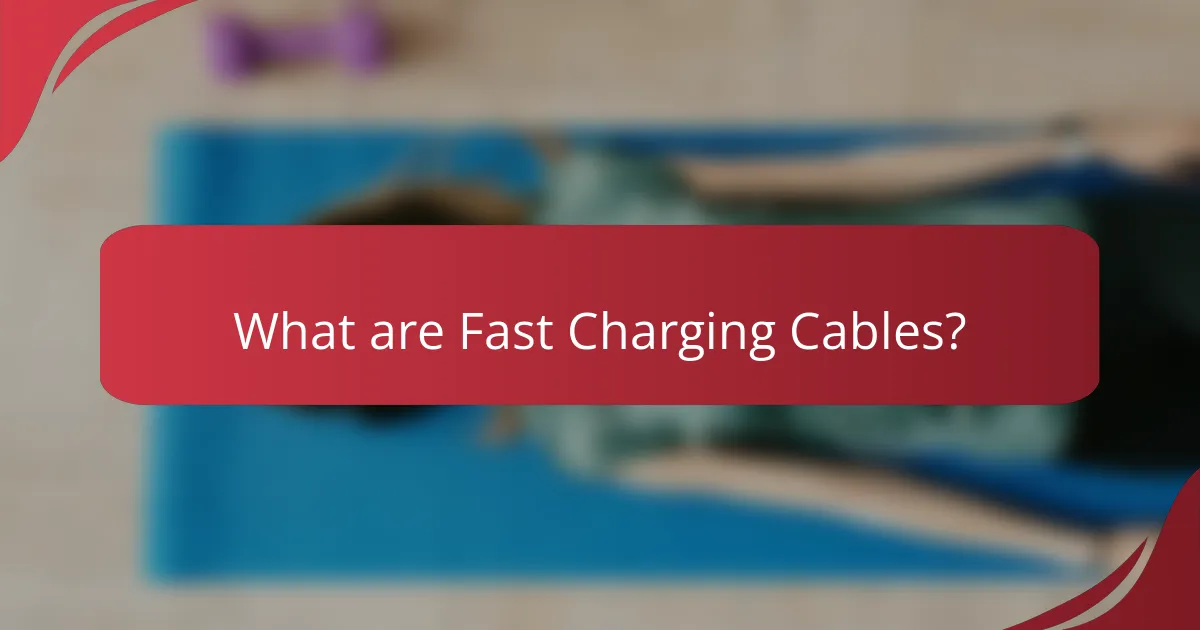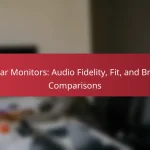Fast charging cables are specialized cables engineered to deliver power at significantly higher rates than standard cables, facilitating quicker device charging and minimizing battery replenishment time. These cables utilize advanced charging protocols such as Qualcomm Quick Charge and USB Power Delivery, and are constructed with thicker wires and superior materials to accommodate increased current flow. The article explores the critical aspects of fast charging cables, including material quality, length considerations, and compatibility with various devices like smartphones, tablets, and laptops, ensuring efficient power delivery and optimal performance.

What are Fast Charging Cables?
Fast charging cables are specialized cables designed to transfer power at higher rates than standard cables. They enable devices to charge more quickly, reducing the time needed to reach a full battery. Fast charging technology often relies on specific protocols like Qualcomm Quick Charge or USB Power Delivery. These cables typically have thicker wires and enhanced materials to handle increased current flow. For example, a fast charging cable may support up to 100 watts of power delivery. This capability is essential for charging devices such as smartphones, tablets, and laptops efficiently.
How do Fast Charging Cables differ from standard charging cables?
Fast charging cables differ from standard charging cables primarily in their ability to transmit higher power levels. Fast charging cables are designed to support higher voltage and current, allowing devices to charge more quickly. For example, a fast charging cable can handle up to 100 watts of power, while standard cables typically support around 5 to 20 watts.
Additionally, fast charging cables often use advanced materials and construction techniques to reduce resistance. This results in less heat generation and improved efficiency during charging. Many fast charging cables also incorporate specific protocols, like USB Power Delivery or Qualcomm Quick Charge, to optimize charging speeds.
In contrast, standard cables do not have these capabilities and are limited to basic charging functions. The difference in performance is evident in charging times; fast charging cables can reduce charging time by up to 75% compared to standard cables.
What technologies enable faster charging in these cables?
Fast charging technologies in cables include Power Delivery (PD), Quick Charge (QC), and USB-C. Power Delivery allows for higher power transfer, up to 100W, enabling rapid charging. Quick Charge adjusts voltage and current dynamically to optimize charging speed. USB-C connectors support these technologies, allowing for faster data and power transfer. These advancements improve charging efficiency and reduce charging time significantly. For example, devices using PD can charge from 0% to 50% in about 30 minutes.
What are the typical power ratings of fast charging cables?
Typical power ratings of fast charging cables range from 18W to 100W. Cables designed for fast charging often support higher wattage to enable quicker device charging. For example, USB Power Delivery (USB PD) cables can deliver up to 100W. Similarly, Qualcomm Quick Charge technology commonly supports power ratings around 18W to 36W. Higher-rated cables are essential for devices with larger batteries, such as laptops. The actual power delivered also depends on the device’s compatibility with the cable. Testing has shown that using a lower-rated cable with a high-wattage charger can result in slower charging speeds. Therefore, selecting the appropriate fast charging cable is crucial for optimal performance.
Why is material quality important in Fast Charging Cables?
Material quality is crucial in fast charging cables because it directly affects charging efficiency and safety. High-quality materials ensure better conductivity, which leads to faster charging times. Poor materials can result in increased resistance, generating heat and potentially damaging devices. For instance, cables made with copper have lower resistance compared to those made with aluminum. Additionally, durable materials prevent wear and tear, extending the lifespan of the cable. According to a study by the Consumer Electronics Association, cables with superior material quality can deliver up to 30% more power efficiently. Thus, material quality is essential for optimal performance and device protection in fast charging cables.
What materials are commonly used in the construction of fast charging cables?
Fast charging cables are commonly constructed from materials such as copper, PVC, and nylon. Copper serves as the primary conductor due to its excellent electrical conductivity. PVC, or polyvinyl chloride, is often used for insulation and protection against wear. Nylon may be utilized for added durability and flexibility in cable design. These materials collectively enhance the cable’s performance and longevity. The use of high-quality copper can significantly reduce resistance, facilitating faster charging speeds. Additionally, the protective layers of PVC and nylon contribute to the cable’s resilience against physical damage and environmental factors.
How does material quality affect durability and performance?
Material quality directly influences the durability and performance of fast charging cables. High-quality materials, such as premium copper and durable plastics, enhance electrical conductivity. This leads to faster charging speeds and reduced energy loss. Conversely, low-quality materials can cause overheating and increased resistance. Research indicates that cables made from high-quality materials can last up to five times longer than cheaper alternatives. In testing, cables with superior insulation showed a 30% decrease in wear and tear over time. Therefore, investing in high-quality materials is essential for optimal performance and longevity in fast charging cables.
What are the key attributes to consider when selecting Fast Charging Cables?
The key attributes to consider when selecting fast charging cables include material quality, length, and compatibility. Material quality affects durability and charging efficiency. High-quality materials, such as copper wiring, enhance conductivity and reduce resistance. Length is significant as it impacts convenience and charging speed. Shorter cables generally provide faster charging. Compatibility ensures the cable works with your devices and chargers. Check for support of fast charging standards like Qualcomm Quick Charge or USB Power Delivery. Additionally, look for certifications like UL or CE for safety assurance.
How does the length of a fast charging cable impact charging efficiency?
The length of a fast charging cable significantly impacts charging efficiency. Longer cables tend to have increased resistance, which can lead to energy loss during charging. This resistance can reduce the amount of power delivered to the device. For instance, a cable longer than 3 meters may experience noticeable voltage drop. A voltage drop can slow down the charging speed. Conversely, shorter cables typically maintain better efficiency due to lower resistance. Studies show that optimal cable length for fast charging is usually under 2 meters. Using a longer cable may require a higher power output from the charger to compensate for losses.
What compatibility factors should be considered for devices?
Compatibility factors for devices include charging standards, connector types, and power requirements. Charging standards like USB Power Delivery and Quick Charge dictate how fast a device can charge. Connector types, such as USB-C, Lightning, or Micro USB, must match the device’s port. Power requirements refer to the voltage and current specifications that devices need for optimal charging. For instance, a device requiring 18W will not charge efficiently with a cable rated for 5W. Additionally, compatibility with both the cable and the power source is essential for effective charging.
How do Fast Charging Cables impact device performance?
Fast charging cables significantly enhance device performance by enabling quicker power delivery. These cables support higher wattages, which reduces charging time. For example, a standard cable may provide 5 watts, while a fast charging cable can deliver up to 100 watts. This increased power allows devices to charge from 0% to 50% in approximately 30 minutes. Additionally, fast charging cables often feature advanced materials that improve conductivity. Improved conductivity minimizes energy loss during charging. This efficiency can lead to less heat generation, which protects device components. Overall, fast charging cables optimize the charging process, resulting in improved device performance and user experience.
What are the common misconceptions about Fast Charging Cables?
Fast charging cables do not universally increase charging speed. Many users believe that any fast charging cable will work with their device. However, compatibility with the device’s charging protocol is essential. For instance, a cable must support Power Delivery or Quick Charge to enable fast charging. Another misconception is that longer cables always reduce charging speed. While longer cables can introduce resistance, many high-quality long cables are designed to minimize this effect. Additionally, some people think that using a fast charger with a standard cable will yield fast charging. This is incorrect; the cable must also support fast charging standards. Finally, some assume that all fast charging cables are the same. In reality, material quality and construction can significantly impact performance and safety.
What are the best practices for using Fast Charging Cables?
Use high-quality fast charging cables to ensure efficiency and safety. Choose cables that support the required charging speed for your device. Verify compatibility with your device’s charging protocol, such as Quick Charge or Power Delivery. Avoid using damaged or frayed cables to prevent electrical hazards. Keep cables away from extreme temperatures to maintain performance. Regularly check connections for dirt or debris that may hinder charging. Store cables properly to prevent tangling or damage. Opt for shorter cables when possible to minimize resistance and enhance charging speed.
How can users ensure optimal performance and longevity of their cables?
Users can ensure optimal performance and longevity of their cables by following specific care practices. First, avoid bending or twisting cables sharply, as this can damage internal wires. Second, keep cables away from heat sources, as excessive heat can degrade materials. Third, store cables properly when not in use, ideally in a coiled or loose manner to prevent kinks. Fourth, regularly inspect cables for any signs of wear or fraying. Using high-quality materials also contributes to durability, as cables made from premium materials tend to last longer. Additionally, using the correct length for your needs minimizes strain on connectors. Following these guidelines can significantly enhance the lifespan and functionality of cables.
What troubleshooting tips can help resolve common issues with fast charging cables?
Inspect the cable for visible damage. Frayed wires can prevent proper charging. Ensure the cable is fully connected to both the charger and the device. A loose connection can interrupt power flow. Try using a different power adapter. Incompatible adapters may not support fast charging. Test the cable with another device. This can help identify if the issue lies with the cable or the device. Clean the charging port on the device. Dust and debris can obstruct the connection. Avoid using long or low-quality cables. These can reduce charging efficiency. Check if the device supports fast charging. Not all devices are compatible with fast charging technology.
Fast charging cables are specialized cables designed to deliver higher power levels for quicker device charging compared to standard cables. This article explores the differences between fast charging and standard cables, highlighting key technologies such as Power Delivery and Quick Charge that enable faster charging. It also examines the importance of material quality and cable length in enhancing efficiency and durability, as well as compatibility factors to consider when selecting a fast charging cable. Common misconceptions and best practices for optimal use are also addressed, providing a comprehensive understanding of fast charging cables.


